
JPY Talking Points:
- Risk aversion continued to show in US markets after news of a rescue package for depositors of Silicon Valley Bank and Signature Bank was announced on Sunday. This sets the stage for tomorrow’s CPI release, which takes on even more importance given the scenario showing in US rates at the moment.
- US rates are falling aggressively and regional banks in the US were getting hit in pre-market trade ahead of the US open. This has driven considerable Yen-strength, as I had noted on Friday that carry unwind could create significant moves in the Japanese currency should risk aversion themes continue to show.
- I’ll be discussing these themes in-depth in the weekly webinar on Tuesday at 1PM ET. It’s free for all to register: Click here to register.
US Rates Falling Fast
It’s a busy morning and there’s a lot going on, so I think it’s probably easiest to highlight what’s going on in global markets through charts, so I will attempt to explain the situation using a series of annotations below.
To recap the situation: US equity markets closed near lows last week as worries had mounted of a possible bank run in the US. Silicon Valley Bank was taken over by the FDIC on Friday morning, and this had led to a cascade of worries about banks that might be in similar positions. And accordingly, we’ve seen a risk-off response in global markets, with JPY strength as US interest rates fall aggressively.
What’s Causing the Problems at Banks?
Namely, interest rtes. Banks have portfolios of investments with depositor capital, and those portfolios are often heavily based in fixed income securities, particularly US Treasuries. Normally this is a ‘good’ thing as the safety of US Treasuries allows the bank to earn a spread between the rates they receive from their investments and the rates they pay out to depositors; and given the perceived safety of those securities, there’s less fear than if this was invested in corporate bonds or something with a wider risk profile.
Ideally, the duration of those treasury investments is very short-term, such as 3-month Treasury Bills, which should contain some of that risk, to a degree. But in a rising rate environment a portfolio of fixed income investments can fast become an albatross as rising rates means the market value of securities paying a sub-standard coupon will accordingly go down. Bond prices and yields move inversely, so as rates go up, the value of a fixed income portfolio will go down, all factors held equal, and the amount that it goes down is often related to the duration or length of the maturity of securities in that portfolio.
As example, below I’m looking at ‘TLT’ which is an ETF representing Treasuries with more than 20 years to maturity. This had fallen by more than 40% in less than a year as the Fed continued to hike rates aggressively last year.
TLT Weekly Chart (indicative only)

Chart prepared by James Stanley; data derived from Tradingview
While this problem has been brewing for months, what’s created the hastening of the scenario was depositors requesting withdrawals, which further strained the banks that were already sitting on unrealized floating losses. And frankly, we don’t know that rates have topped yet.
Rates have moved up very quickly over the past year as the Fed attempts to get a handle on inflation, sinking the value of fixed income portfolios. If the investments are held to maturity the principal will be returned; but if the securities are sold before maturity, it will be at the current market price, and this is what creates the start of the issue as depositors had started to quickly withdraw their assets at the first sign of possible trouble, and as some depositors withdraw, others are encouraged to do the same.
Because after all, the risk of holding capital through a bank collapse, at least beyond FDIC insurance protection, is immense; while the possible reward is somewhat negligible, by comparison (you get to keep your own money).
This is why bank runs can create self-fulfilling prophecies: Because even if there isn’t an actual problem at the bank, if enough investors withdraw and show panic, others can be encouraged to also withdraw, which can then create a ‘run on the bank,’ thereby exacerbating or perhaps even creating the problem.
This is what caused the FDIC to take over Silicon Valley Bank last week as depositors were withdrawing cash in droves.
What About the Rescue Package?
On Sunday night US regulators announced that depositors from Silicon Valley Bank will be made whole, which was a relief to tech companies that kept their treasury accounts at the bank and were going to need to make payroll. But – it was also announced that this was not a bailout as equity and bond holders of Silicon Valley Bank were going to be wiped out.
But, by that time it seems the contagion had already started to spread to other banks with similar issues. First Republic Bank was cited several times across social media as another point of worry and there were videos circulating of long lines at these banks over the weekend, presumably of depositors looking to withdraw funds. And, again, this is a social theme so just the sight of such a scenario can compel others to do the same. As we open US markets this week it appears as though regional banks are taking a hit and this can create further pressure across markets.
The chart below highlights the equity in First Republic Bank, with another gap down in the equity this morning.
First Republic Monthly Chart (indicative only)
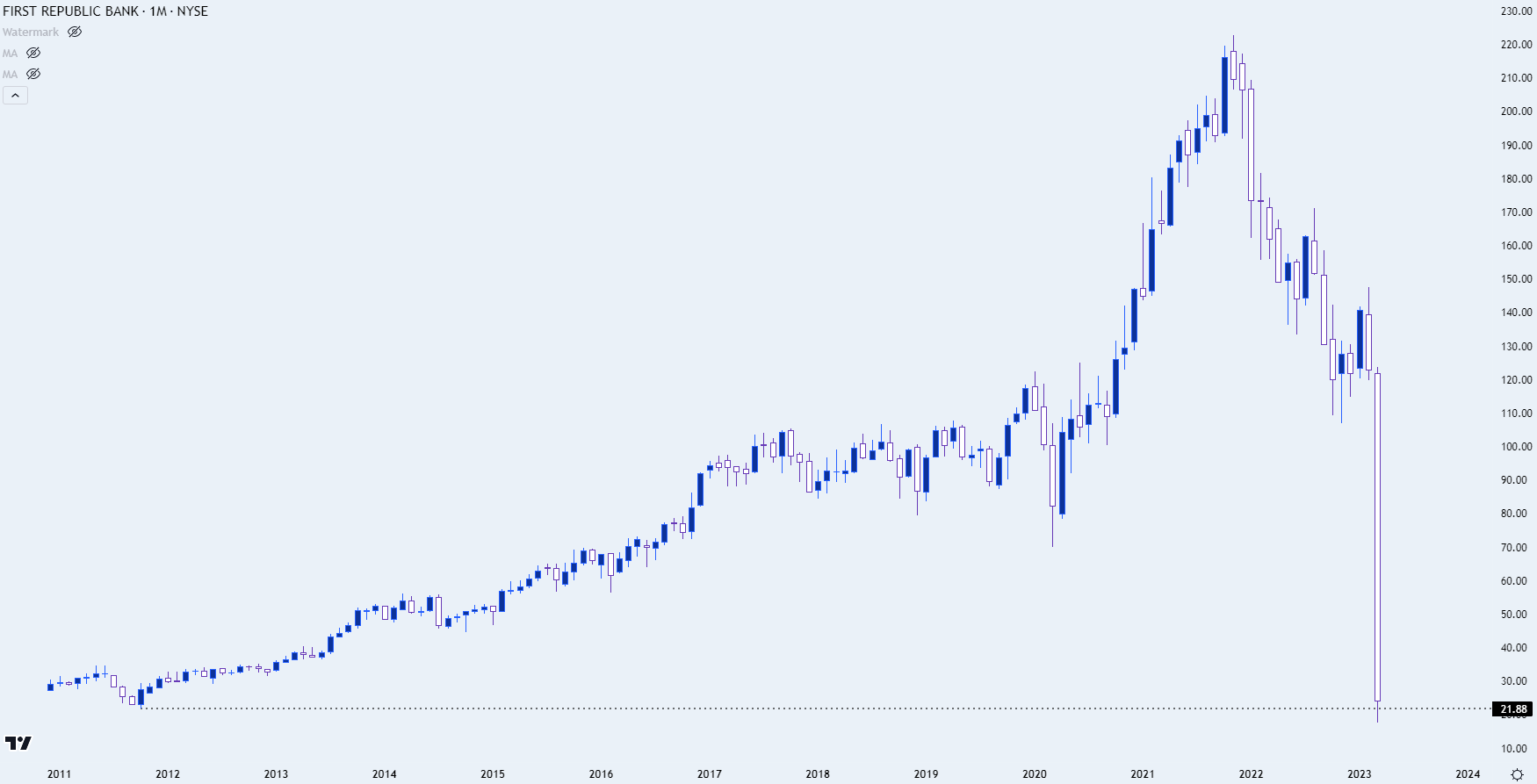 Chart prepared by James Stanley; data derived from Tradingview
Chart prepared by James Stanley; data derived from Tradingview
US Rates
Perhaps the most dramatic market moves have shown in US Treasuries. The two-year note hit 5% last week and this morning it dropped down to a low of below 4%. This highlights some aggressive Treasury buying from market participants which can be commonplace in a risk aversion scenario. The pace of this move, however, is notable, and this indicates extreme anxiety that hasn’t yet abated, despite the weekend announcement.
US Treasury Two-Year Note Yield (Indicative only)
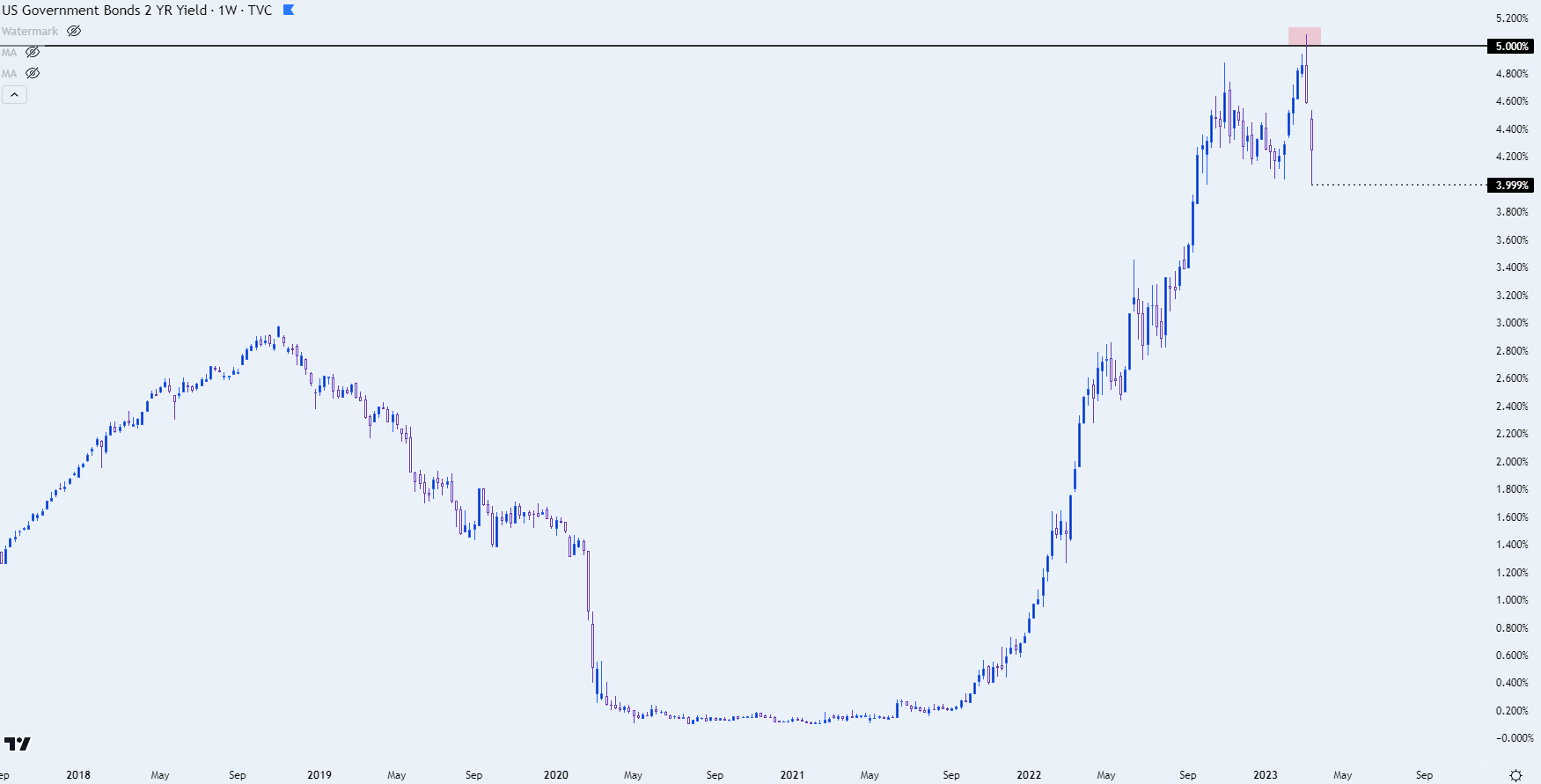 Chart prepared by James Stanley; data derived from Tradingview
Chart prepared by James Stanley; data derived from Tradingview
How Does This Impact Fed Policy?
Rightfully a major question after a move of this nature is how it might impact FOMC policy. And given the bank’s continued fight with inflation, it’s not a clear-cut argument of backing off rate hikes due to the possible macro-prudential risk of continuing with higher rates.
But from a market perspective, there’s been a fast re-pricing of near-term rate hikes, key of which is the FOMC rate decision on March 22nd. Last week saw probabilities of a 50-basis point hike move past 70%. Today, that’s at zero, and there’s even some element of expectation for no rate hike at all at next week’s meeting, currently showing at 38.7%.
Tomorrow’s CPI release brings a curveball to the equation as a strong inflationary read spells out the need for more-hawkish Fed policy. But is the Fed concerned about what’s showing in banking and might that macro-prudential risk dictate a softer hand from the FOMC? Normally we’d have a plethora of Fed-speak to draw from but given the proximity of the rate decision, we’re going to have to wait, as the FOMC is now in a blackout window ahead of that rate decision. This means that, by design, we won’t be hearing from Fed members until a couple of days after that next rate announcement.
Rate Hike Probabilities for March FOMC Rate Decision
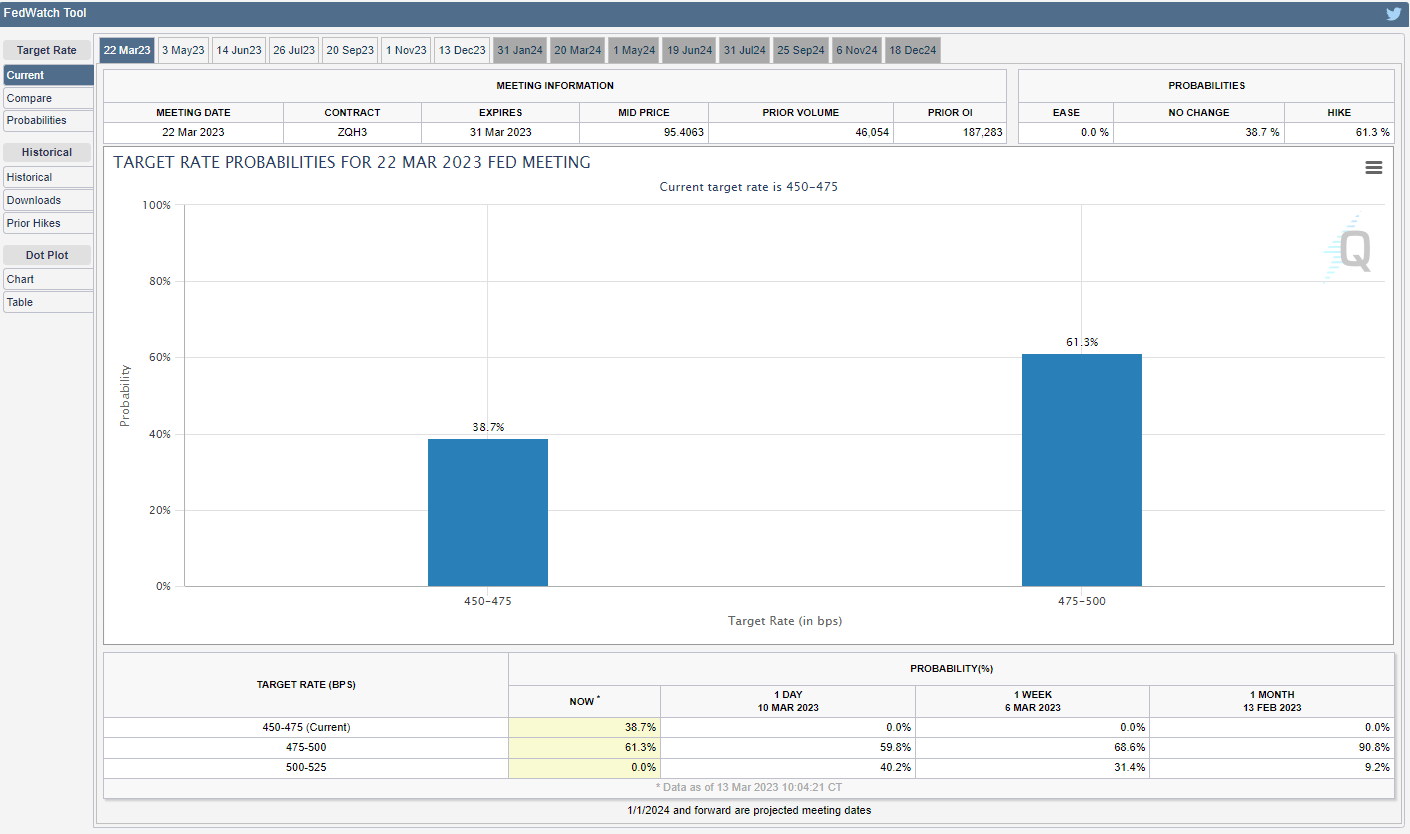 Data derived from CME FedWatch, as of March 13th, 2023
Data derived from CME FedWatch, as of March 13th, 2023
What Are Impacts to the FX Market?
One of the more obvious impacts to the FX market is US Dollar weakness as rate hike probabilities get priced-out and as US rates head-lower.
But that’s not the only impact, and I discussed this topic on Friday in reference to the Japanese Yen. As I had written, “While USD strength may tend to show during periods of risk aversion, given the impact of the carry trade over the past couple of years in the pair, we could fast see a carry unwind scenario that drives Yen-strength against USD weakness, particularly if that risk aversion theme is coupled with falling rates on the back of macro anxiety. And that theme of Yen-strength may even be extrapolated elsewhere, such as GBP/JPY.”
That scenario has started to play out and USD/JPY is breaking-below the higher-low support that had built over the past month. The level that I had highlighted on Friday was at 133.09, but that’s already been traded through this morning as carry trade unwind has hit the Japanese Yen.
A way of thinking of this is in relation to rates: As US rates were heading higher while Japanese Yen rates were held flat by a loose and passive Bank of Japan, USD/JPY continued to trend higher through much of 2021 and the first nine months of 2022. But as the prospect of a Fed pause started to come into the picture, USD/JPY began to pullback, even through the carry remained tilted to the long side, on the premise that the carry trade that drove the pair higher may begin to unwind.
USD/JPY Daily Chart
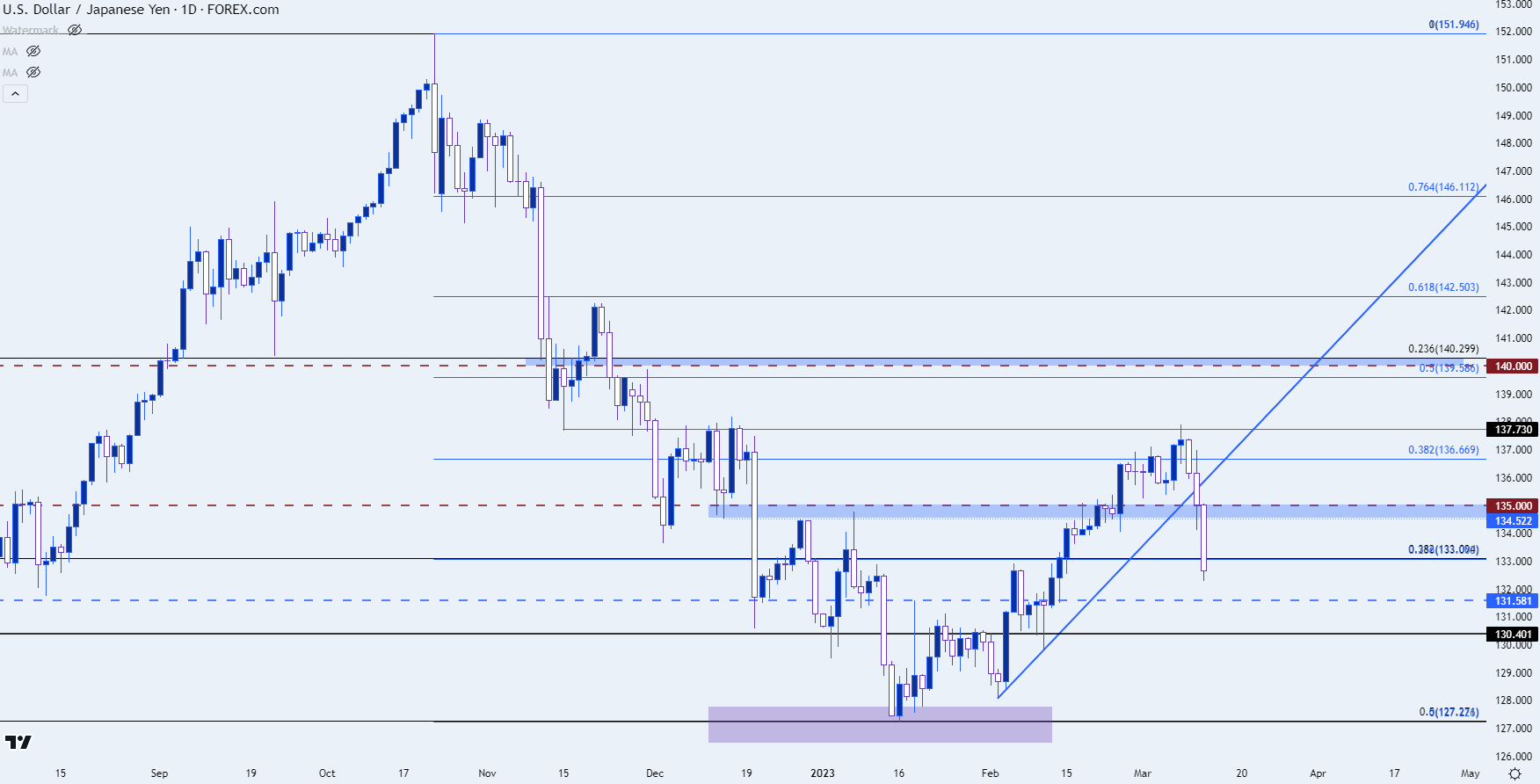 Chart prepared by James Stanley, USD/JPY on Tradingview
Chart prepared by James Stanley, USD/JPY on Tradingview
If we do see continued compression in rates, this could carry a toll on other Yen-pairs, as I had mentioned on Friday. GBP/JPY is more than 2% below it’s Friday closing price at this point, although it has seen a bounce just above the 160 psychological level. There’s an area of possible resistance as taken from prior support, around the 161.77 level, after which resistance potential shows around the 163 handle.
GBP/JPY Four-Hour Price Chart
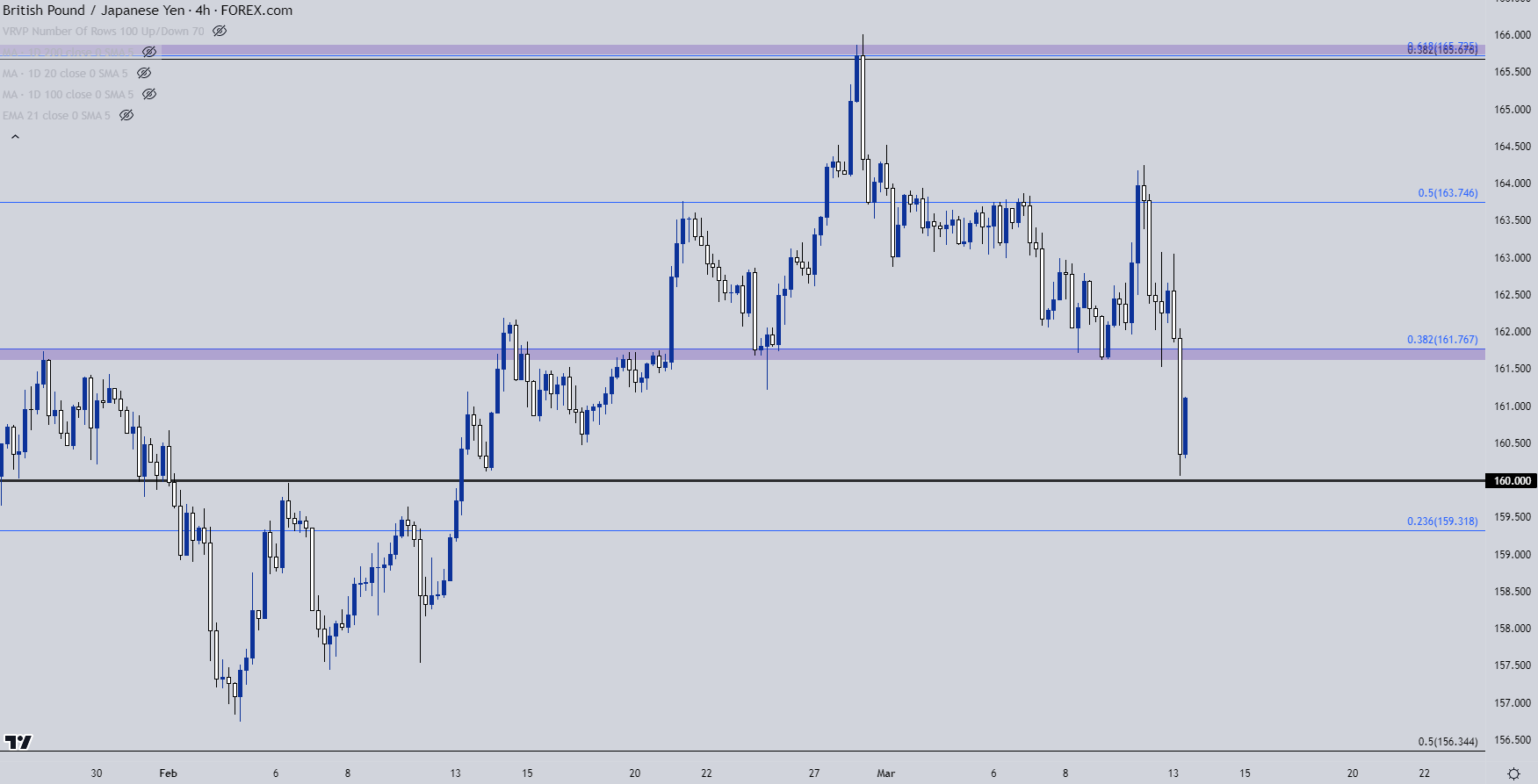 Chart prepared by James Stanley, GBP/JPY on Tradingview
Chart prepared by James Stanley, GBP/JPY on Tradingview
If this situation does develop into a wider scenario of lower rates and greater risk aversion, there could still be room for the Yen to run, similar to what showed up in Q4 of last year when US rates were falling.
In USD/JPY, price held the 50% mark of the 2021-2022 major move at 127.27 when it came into play in mid-January. That becomes a notable spot on the chart to follow, along with the 130 psychological level.
USD/JPY Weekly Chart 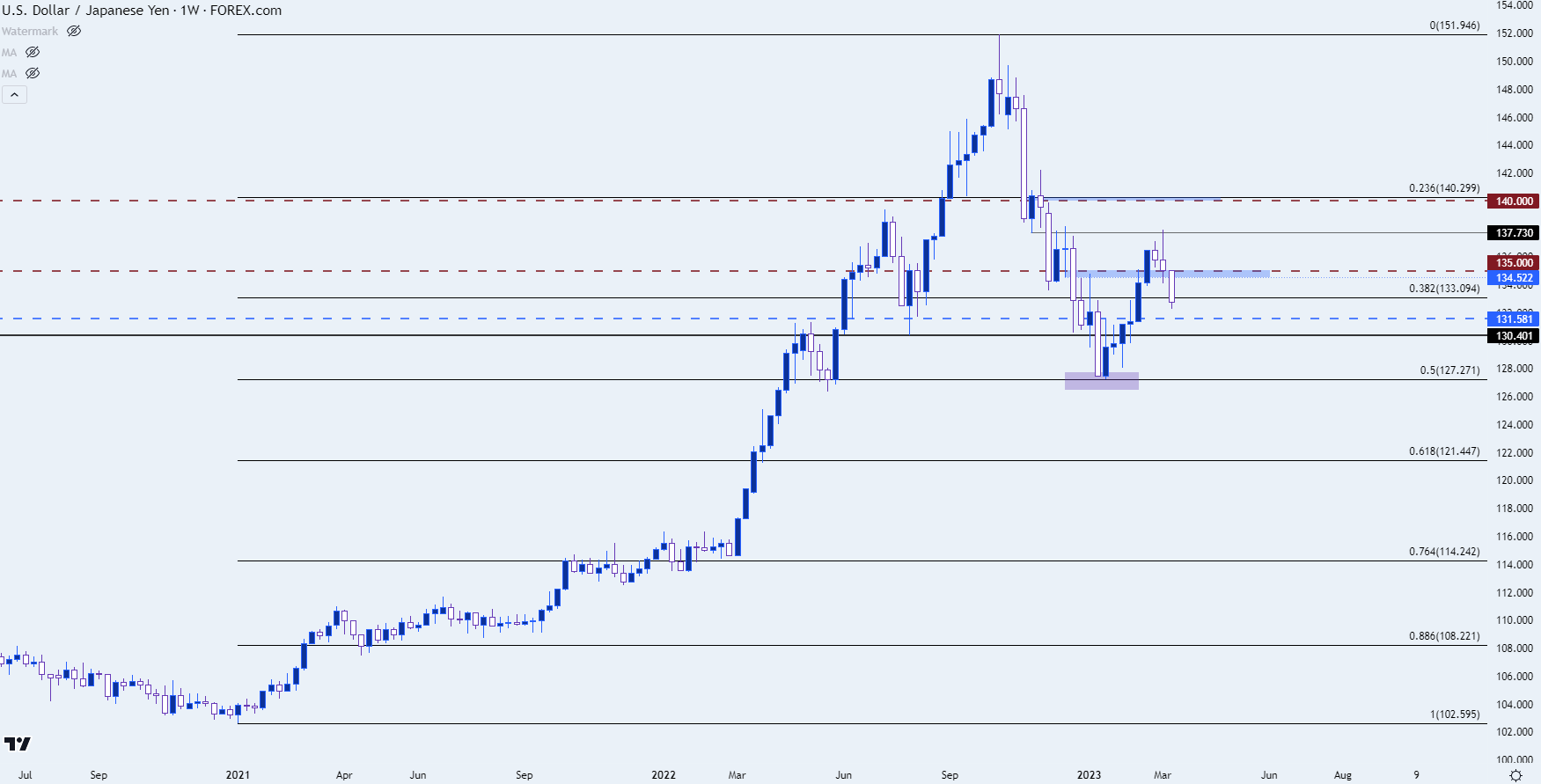
Chart prepared by James Stanley, USD/JPY on Tradingview
What Happens From Here?
To quote the analyst Peter Sullivan from the movie Margin Call, ‘well, this is where it becomes a projection.’
Risk is continuing to show around regional banks and at this point regulators haven’t addressed those concerns. That can continue if left unaddressed and if you’re a deposit holder at one of these institutions, watching the company’s stock price fall dramatically after similar banks were already taken over by FDIC, well that could potentially lead to even more withdrawals from depositors, especially large accounts the eclipse the $250k limit for FDIC protection.
The bigger direct concern, given the regulators actions over the weekend, would be to investors in the bank itself as equity and bondholders were both wiped out. And if there’s little to no prospect of a government bailout, there’s a less attractive thesis for remaining long those securities. This is what creates contagion and if you’re tracking the stock prices of banks, it appears as though it’s already begun.
But – if the US government is going to backstop deposits, like what was announced over the weekend, then deposit holders may have some element of safety from that action; but it’s impossible to know if that same package will be extended to other scenarios and until there is confirmation of such, there will likely be some degree of worry around that theme. When investors do have access to funds, they will likely at least consider moving assets to another bank which, again, can exacerbate the problem. And that further exposes those banks as the precedent has been established that deposit holders will be protected while equity and bond holders will not.
Will This Become a Larger Macro Risk-Off Event?
Again, it’s a projection, but the fact that regulators have stepped-in to protect deposit holders can provide some element of protection to those who have deposits at the bank. This could create continued volatility in bank shares, and this is something that could possibly create turmoil in banking as investors withdraw from smaller, less capitalized banks and move towards larger banks.
The hope being that the government’s actions stem the ‘run on the bank’ scenario that could fast turn these unrealized risks into realized losses, and that seems to be the negative scenario that regulators are looking to avoid, but until risks at regional banks are addressed this situation could continue to evolve.
In terms of long-term repercussions, tomorrow’s CPI report is perhaps even more important now. If we see a hot reading, putting more pressure on the Fed, there could be a macro risk event in US equities as the central bank is painted into a corner between macro-prudential risks and inflation.
In the S&P 500, the area to watch is around the 3800 level, which held the lows in December. If sellers are able to take out that support, last year’s lows become a downside target for bears and that’s just above the 3500 level for the index.
At this point, the S&P 500 is holding support from prior trendline resistance. The weekly chart, albeit very early, is showing as a doji as the sell-off that started to develop this morning was unable to extend. If we see a daily close below 3802, however, that support from prior resistance is broken, and this would also equate to a fresh four-month-low in the index.
S&P 500 Weekly Chart (Indicative only)
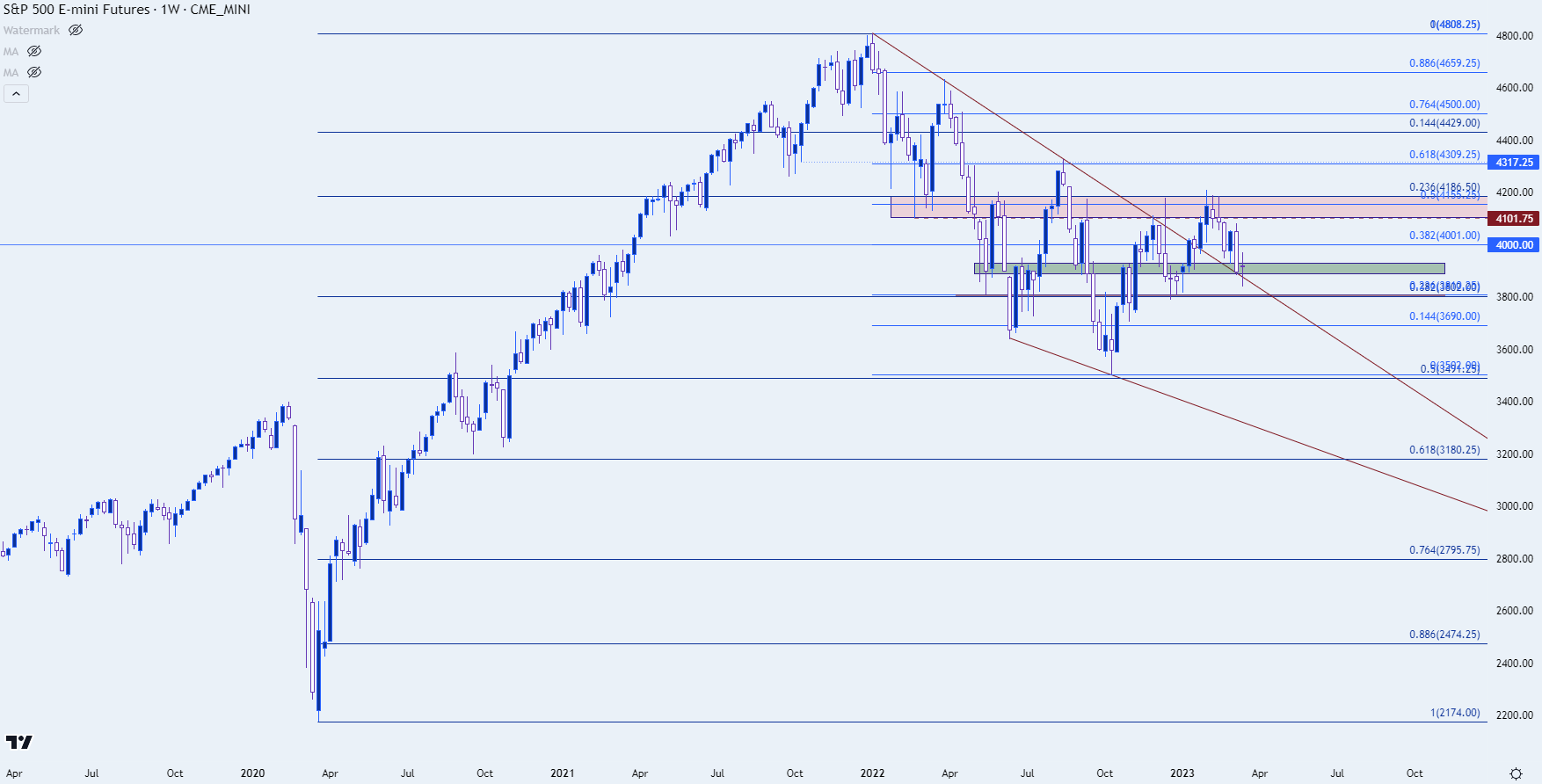 Chart prepared by James Stanley; data derived from Tradingview
Chart prepared by James Stanley; data derived from Tradingview
--- written by James Stanley, Senior Strategist
Follow James on Twitter @JStanleyFX



